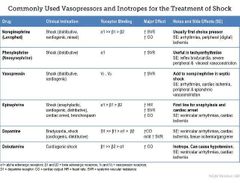![]()
![]()
![]()
Use LEFT and RIGHT arrow keys to navigate between flashcards;
Use UP and DOWN arrow keys to flip the card;
H to show hint;
A reads text to speech;
11 Cards in this Set
- Front
- Back
- 3rd side (hint)
|
What is the issue with enteral nutrition for patient on pressor support |
Bowel ischemia |
|
|
|
Who is safe? |
Low / stable dose of pressors are ok . Less than 12.5 mcg/min levophed |
|
|
|
Who is at risk |
High dose or escalating pressor dose |
|
|
|
Cyanide toxicity abnormal lab value |
Elevated lactic acid greater than 10 is both sensitive and specific |
Impaired Mitochondrial function |
|
|
What is driving pressure |
Driving pressure or DP is the difference between plateau pressure (pPlat) and positive end-expiratory pressure (PEEP) and represents the tidal volume (Vt) corrected for the patient’s static compliance (CRS) |
|
|
|
Importance of driving pressure( ∆P) |
Driving pressure is significantly related to lung stress, and driving pressure higher than 15 cm H2O is associated with dangerous levels of stress. Using driving pressure as a safety limit and not just the low tidal volume and plateau pressure less than 30 cm H2O, may be a better way to adjust Vt in order to decreases cyclic or dynamic strain during mechanical ventilation.Among ventilation variables, ΔP was most strongly associated with survival. A 1-SD increment in ΔP (approximately 7 cm H2O) was associated with increased mortality |
|
|
|
What are recommendations for ARDS |
Strong recommendations : - lower tidal volumes (4-8 mL/kg predicted body weight) -lower inspiratory pressures (plateau pressure < 30 cm H2O) - prone positioning for more than 12 hours per day. Conditional recommendations : - higher positive end-expiratory pressure -recruitment maneuvers for those with moderate to severe acute respiratory distress syndromewith a P/F ratio less than 100 |
|
|
|
Who gets emphysematous pyelonephrits |
Poorly controlled diabetes |
|
|
|
Management of emphysematous pyelonephritis |
Nephrectomy |
|
|
|
When cant we use flotrack for SVV |
1. When patient is not in sinus 2. When TV is varying with each breath |
|
|
|
What Is the pressor of choice and site of action in: Distributive shock Spinal shock Cardiogenic shock |

|
|

